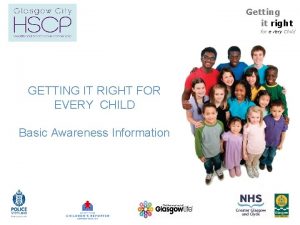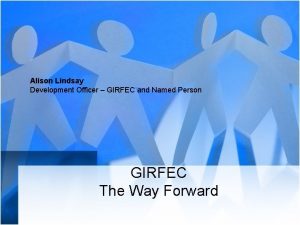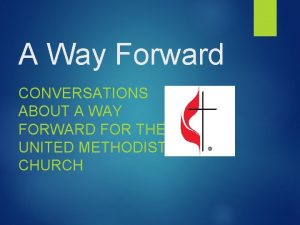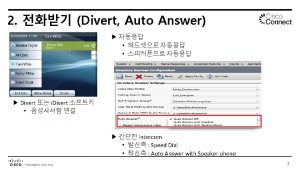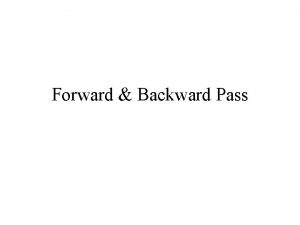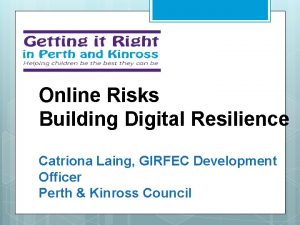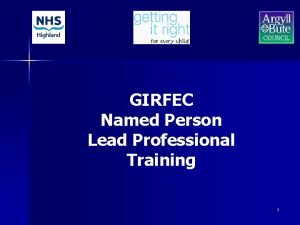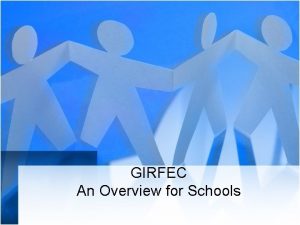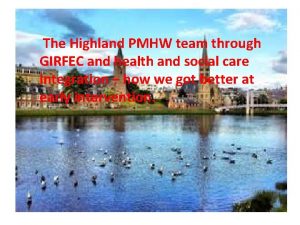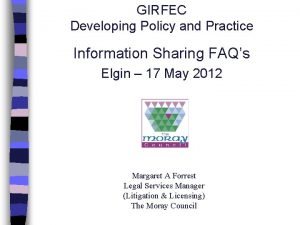GIRFEC The Way Forward Part A Autumn 2013










































- Slides: 42

GIRFEC The Way Forward Part A – Autumn 2013

Learning Intentions By the end of this session you will have: • an understanding of the legislative context of GIRFEC • an understanding of the revised Continuum of Support • an operational understanding of how the new processes fit within the Co. S • an action plan to support implementation of the new approach in your school • Awareness of e-learning tool for all staff

Why GIRFEC? • 2006 Scottish Executive introduced the GIRFEC approach • Subsequent policies encompass GIRFEC including: – – The Early Years Framework Curriculum for Excellence We Can and Must do Better Equally Well • Children and Young Person Bill

Children and Young People (Scotland) Bill • Proposed GIRFEC duties: • Local Authority Children Service Plans • Agreed definition of wellbeing (SHANARRI) • Named Person Role • Single Child’s Planning Process • Statutory duties to share information

Reminder of the Principles of GIRFEC • Promoting the wellbeing of individual children and young people • Intervening early in the process to facilitate positive change • Keeping children and young people safe • Putting children at the centre • Building on strengths and promoting resilience • Working in partnership with families • Respecting confidentiality and sharing information • Making the most of bringing together each worker’s expertise

Could GIRFEC have made a difference? “The essence of GIRFEC, is that an integrated approach should be taken towards the wellbeing of children. It includes a proposal that every child should have a “named person”, to act as a conduit for any concerns about the child’s wellbeing and to address them, either by helping parents access additional support or, if the child is deemed to be at risk, by getting other agencies or social services involved. Every time another child dies at the hands of their carers, the cry goes up: “Never again”. Imagine if that promise – made and broken so many times – could one day be delivered on. ” http: //www. scotsman. com/news/dani-garavelli-fatal-mistakes-1 -3029459

Information Commissioner Statement “While it is important to protect the rights of individuals, it is equally important to ensure that children are protected from risk of harm. ” “If there is any doubt about the wellbeing of a child, the Data Protection Act should not be viewed as a barrier to proportionate sharing. ” Ken Macdonald, Assistant Information Commissioner for Scotland & Northern Ireland

5 Key GIRFEC Questions 1. What is getting in the way of this child or young person's well-being? 2. Do I have all the information I need to help this child or young person? 3. What can I do now to help this child or young person? 4. What can my agency do to help this child or young person? 5. What additional help, if any, may be needed from others?

SHANARRI •


My World Triangle • Main tool for assessing a child’s current circumstances • Identifies strengths and pressures in all aspects of a child’s life • Introduces a mental map • Helps practitioners explore a child’s experience • Identify needs and risks to a child’s wellbeing

Resiliency Matrix for Analysing Information Resilience Normal development under difficult conditions e. g. secure attachment, outgoing temperament, sociability, problem solving skills Protective Environment Factors in the child’s environment acting as buffer to the negative effects of adverse experience Adversity Life events or circumstances posing a threat to healthy development e. g. loss, abuse, neglect Vulnerability Those characteristics of a child, their family circle and wider community which might threaten or challenge healthy development e. g. disability, racism, lack of or poor attachment Daniel, B. and Wassell, S. (2002) Assessing and Promoting Resilience in Vulnerable Children

Resiliency Matrix • Information may already be gathered around My World Triangle along with more specialist information • For some children, can be used simply as a mind map to make sense of information and to plan next steps. • For children who are experiencing more complex difficulty, strengths and pressures experienced by the child can be plotted on blank Resiliency Matrix

The National Practice Model

Key Roles – Named Person The legislation will ensure that all children and young people from birth up to the age of 18 have access to a Named Person • • • pre-birth to 10 days: 11 days to school entry P 1 to P 7 S 1 to S 6 S 4 -S 6 (not in school) the midwife the health visitor the head teacher to be decided

Key Roles – Named Person • • Main point of contact for a family Involve families in decision making Record concerns that are raised Use the GIRFEC framework to assess the needs of the child and plan for meeting needs Be responsible for the implementation of a single agency plan Ensure information is shared with the right people at the right time Contribute to planning for children who need extra help at key transition points. The role of the Named Person should be no more than they currently do in the course of their work.

Key Roles – Lead Professional • Act as the main point of contact for the child and family and relevant practitioners in relation to the Child’s Plan • Ensure the Child’s Plan is accurate and up-to-date, implemented and reviewed • Support the child and family to understand what is happening, ensure their views and wishes are heard and involve them in decisions that affect them • Make sure the child is supported through key transition points and ensure a careful and planned transfer of responsibility especially when another practitioner becomes the Lead Professional and/or responsibility reverts to the role of the Named Person.

Single Child’s Plan • One plan, to be used by a single agency or several agencies working together to support the child. • As Getting it Right for Every Child is being implemented nationally, the Child’s Plan Meeting will streamline the functions of existing forums, such as Looked After Children Reviews, Child Protection Case Conferences, reviews of children’s health and Co-ordinated Support Plan reviews. • The format and attendees of the Child’s Plan Meeting will reflect the complexity of the child’s needs and circumstances. • The Child’s Plan is co-ordinated by the/a Lead Professional.

GIRFEC in West Lothian

Planning Pathways Overview

Level 1 Co. S: Named Person Responsibilities Wellbeing Concerns process • Main point of contact for the family / public and other professionals regarding the child • Wellbeing Concerns Form to be used to record concerns and to plan for further action • Points to consider: – How will this be used in our school/agency? – How could it be used to record plans that already take place? eg. IEP consideration, Sf. L discussions, decisions about within school additional support

Wellbeing Concern Form

Level 2 Co. S: Named Person responsibilities Assessment of Wellbeing process • The Assessment of Wellbeing form is the start of the Single Child’s Planning process and is part of the Single Child’s Plan. • Designed to support the Named Person in taking decisions about further action • Proforma is a place to record all information about an individual child • Proforma aids decision making process for the Named Person • Propose that process is implemented initially for all children for whom it is appropriate in Nursery, Primary 7, current S 1 and any children currently at Level 3 of Co. S. Ultimately, this requires to be in place for all pupils. Points to consider: How can we plan to implement this for the pupils as outlined above? How can it support processes already in place in our school? How could this be used in within my agency setting?

Assessment of Wellbeing form

Chronologies “Chronologies have become one of the most talked about and least understood tools in modern social care practice” SWIA Practice Guide Chronology’s 2010

Definition of a Chronology A chronology is a factual record of a significant event or change in circumstances (either progress or concern) that impacts on the child’s safety, welfare and / or development. It is a tool to be used in partnership with children, young people, parents, carers and practitioners so that everyone can understand respond to the unique circumstances and experience of each individual child or young person and the impact on their lives.

Core elements of a Chronology • Key dates of birth, life events, moves etc • Transitions, life changes • Key professional interventions, reviews, hearings etc • Facts • Brief note of an event and reason for its significance • Source of information • The actions which were taken, including no action

Chronology Format Date of Event Detail of Event Action Taken Outcome Wellbeing indicator Code Brief description of the event, including the name of reporter A description of the event and any actions taken A description of any outcomes from the action taken The most relevant SHANARRI indicator (Safe, Healthy, Active, Nurtured, Achieving, Respected, Responsible , Included) Each recorded chronology item should be appropriately graded for significance.

Chronologies • responsibility of Named Person • helps to keep track of children’s situation • allows for a historical perspective on circumstances and may suggest needs

Level 2/3 Co. S: Named Person / Lead Professional Child’s Planning Meetings • Aim to streamline the process for schools and children/families • Importance of pre-meeting preparation • Strengths based approach (training to follow) • Clearer recording and action planning process • Decision about whether a Lead Professional is required should be considered at the meeting

Pre-Meeting preparation (professionals)

Pre-Meeting Preparation (Ch&YP)

Child’s Planning Meeting

Child’s Planning Meeting

Continuum of Support Level 4: SORG • Presumption of Mainstream • Remit of SORG (regular & transition) • SORG referrals and feedback

Overview of Support Educational Psychology Service IT Support Autism Outreach Service Primary Behaviour Outreach Secondary Behaviour Outreach Dyslexia ADHD Outreach Hearing Impaired Service English as an Additional Language Home and Hospital Outreach Language Outreach Access Services Child Protection Officer Looked After Children Outreach Pre-School Home Teaching Service Music Therapy Community Child Health Child and Adolescent Mental Health Service Occupational Therapy Speech and Language Therapy Physiotherapy Social Policy Children and Disabilities Team Criminal Justice Children and Young People’s Team Reporter to the Children’s Panel Community Policing

E-Learning Tool • Background Lothian and Borders comprising of Edinburgh City Council, Midlothian Council, East Lothian Council, West Lothian Council, Scottish Borders Council, NHS Lothian & NHS Borders have all worked together to produce a foundation level interactive E- Learning module to increase knowledge and understanding of GIRFEC. • Expectations All council staff will access and complete. All other agencies will have access and complete, including the voluntary sector.

E-Learning Tool • TABLE OF CONTENTS • • • • AIMS & LEARNING OBJECTIVES INTRODUCTION THE GETTING IT RIGHT APPROACH VIEWS OF CHILDREN AND YOUNG PEOPLE NATIONAL PRIORITIES THE 5 KEY QUESTIONS TO GETTING IT RIGHT FOR EVERY CHILD THE NAMED PERSON THE LEAD PROFESSIONAL THE NATIONAL PRACTICE MODEL SINGLE PLANNING PROCESS MANAGING CONCERNS, RISKS AND INFORMATION SHARING CHRONOLOGY SUMMARY ASSESSMENT & RESOURCES

• INTRODUCTION • Lothian Borders comprising of Edinburgh City Council, Midlothian Council, East Lothian Council, West Lothian Council, Scottish Borders Council, NHS Lothian & NHS Borders recognised the importance of a commonality of approach in the implementation of GIRFEC and have worked together to produce a foundation level interactive E- Learning Module. This

Action Plan and next steps • What do we need to do now to: – embed the roles of the Named Person and Lead professional within our school / setting? – implement the Wellbeing Concerns process? – implement the Assessment of Wellbeing Process? – bring our school’s approach to chronologies in line with GIRFEC guidance?

Follow Up Support • ASN Team – SORG – Alison Raeburn – Chronologies – Alan Millar – Child’s Planning Meetings – Jennyfer Mc. Niven • School EP (process and meetings) • What support would you need to communicate the GIRFEC guidance with staff? • E-Learning Tool for all staff

Accessing the Documents Edweb: ASN section http: //www. westlothian. gov. uk/article/3083/ GIRFEC
 E ery
E ery Girfec 5 key questions
Girfec 5 key questions Girfec pathways
Girfec pathways Forward rate adalah
Forward rate adalah Forward rate dan forward market
Forward rate dan forward market Grows model
Grows model Way forward presentation
Way forward presentation Relative frequency two way table
Relative frequency two way table Perbedaan one way dan two way anova
Perbedaan one way dan two way anova Advantage of threaded binary tree
Advantage of threaded binary tree Perbedaan two way anova dan one way anova
Perbedaan two way anova dan one way anova 2 way anova example
2 way anova example One way anova vs two way anova
One way anova vs two way anova Pengertian two way anova
Pengertian two way anova The old way and the new way
The old way and the new way The one was a ship
The one was a ship Talk this way
Talk this way Understand quran course 2 pdf
Understand quran course 2 pdf Hình ảnh bộ gõ cơ thể búng tay
Hình ảnh bộ gõ cơ thể búng tay Lp html
Lp html Bổ thể
Bổ thể Tỉ lệ cơ thể trẻ em
Tỉ lệ cơ thể trẻ em Voi kéo gỗ như thế nào
Voi kéo gỗ như thế nào Glasgow thang điểm
Glasgow thang điểm Chúa yêu trần thế alleluia
Chúa yêu trần thế alleluia Các môn thể thao bắt đầu bằng tiếng chạy
Các môn thể thao bắt đầu bằng tiếng chạy Thế nào là hệ số cao nhất
Thế nào là hệ số cao nhất Các châu lục và đại dương trên thế giới
Các châu lục và đại dương trên thế giới Công thức tính độ biến thiên đông lượng
Công thức tính độ biến thiên đông lượng Trời xanh đây là của chúng ta thể thơ
Trời xanh đây là của chúng ta thể thơ Mật thư tọa độ 5x5
Mật thư tọa độ 5x5 101012 bằng
101012 bằng Phản ứng thế ankan
Phản ứng thế ankan Các châu lục và đại dương trên thế giới
Các châu lục và đại dương trên thế giới Thơ thất ngôn tứ tuyệt đường luật
Thơ thất ngôn tứ tuyệt đường luật Quá trình desamine hóa có thể tạo ra
Quá trình desamine hóa có thể tạo ra Một số thể thơ truyền thống
Một số thể thơ truyền thống Cái miệng xinh xinh thế chỉ nói điều hay thôi
Cái miệng xinh xinh thế chỉ nói điều hay thôi Vẽ hình chiếu vuông góc của vật thể sau
Vẽ hình chiếu vuông góc của vật thể sau Nguyên nhân của sự mỏi cơ sinh 8
Nguyên nhân của sự mỏi cơ sinh 8 đặc điểm cơ thể của người tối cổ
đặc điểm cơ thể của người tối cổ Thế nào là giọng cùng tên
Thế nào là giọng cùng tên Vẽ hình chiếu đứng bằng cạnh của vật thể
Vẽ hình chiếu đứng bằng cạnh của vật thể
